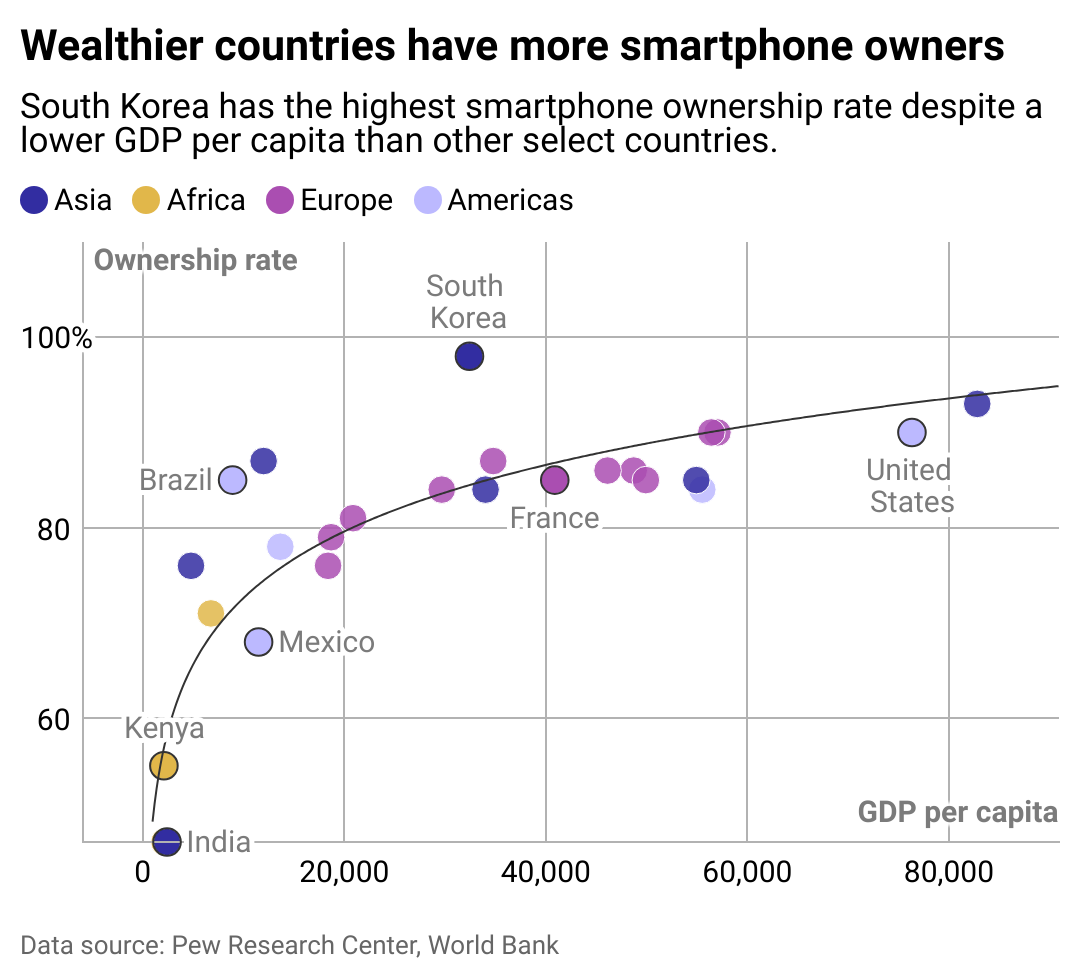
The vast majority of American adults own a smartphone. Here's how that compares to the rest of the world.
This story originally appeared on Spokeo and was produced and distributed in partnership with Stacker Studio.
The vast majority of American adults own a smartphone. Here's how that compares to the rest of the world.
Once a novelty, there's hardly an aspect of modern life that hasn't been touched in some way by cellphones. With the advent of smartphones, people are doing much more than making calls, managing their calendars and email, and racking up points collecting colored gems.
The high-tech computing abilities—100,000 times more processing power than the computer that landed a man on the moon—and audio-visual features of smartphones have surgeons using them to send pictures and consult with colleagues during surgery, farmers managing their irrigation schedules and equipment, and citizens on the front lines of wars sharing firsthand footage and experiences in real time.
But the fact that smartphones are "everywhere" means those who can't afford to have one find themselves on the farther side of a growing digital divide. Compared to their connected counterparts, those without smartphones face higher barriers to accessing remote education, obtaining remote work, using telehealth services, and more.
According to Pew Research Center, 27% of adults in low-income households are only able to go online via their smartphones and don't have additional internet-connected devices or personal computers. But just because they can go online doesn't mean they can stay there. Using a smartphone for internet access can be less reliable than a dedicated broadband line, especially if cellphone towers in their area are sparse. People using their smartphones as a mobile hot spot may also experience constrained bandwidth if several members of a multifamily household are attempting to tether to the same device at once.
During the switch to mass remote schooling during the COVID-19 pandemic and despite schools handing out hot-spot devices, many children were unable to participate in school activities and classroom learning because of a lack of cell towers around their homes. To try to access Wi-Fi, some families had to congregate around libraries, schools, and fast-food parking lots.
To examine this important and often overlooked issue, Spokeo used data from the Pew Research Center and the World Bank to explore smartphone ownership rates around the globe.

Smartphone popularity in the US
Despite the barriers low-income individuals face in obtaining a device, in 2023, U.S. smartphone adoption reached 90% compared to 97% for any kind of cellphone, according to Pew. That's more than double the smartphone adoption rate from just over a decade ago, when smartphone adoption was about 35% and any kind of cellphone was about 83%.
Rural adults in the U.S. are less likely to have smartphone access, with just 80% saying they have one, compared to 84% of suburban and 89% of urban adults. This can be a hindrance when it comes to paying online bills, finishing schoolwork, receiving unemployment benefits, using banking services, or any number of modern, everyday tasks. Those without unlimited data plans can also find their connectivity interrupted if they exceed their data caps.

Smartphones are prominent across the globe
The U.S. outpaces most countries in terms of smartphone ownership. In comparison, Indian and Nigerian smartphone ownership is just 47%, Mexico is 68%, and France is 85%.
A country's GDP is the biggest determinant of smartphone adoption, with wealthier countries boasting higher adoption rates. This gap between the connected device haves and have-nots, an extension of existing income inequalities, has given rise to a new movement asserting that digital connectivity is a new human right. Advocates for this cause contend that connectivity doesn't just connect people to people, it connects people to information, like important health news during pandemics and remote education opportunities.
"Digital connectivity should be a human right. It enables access to information, education, and opportunity," Anne-Marie Grey, Executive Director and CEO of USA for UNHCR, wrote in a statement. "Those who are not connected are living in a very different world."
Amnesty International has likened the internet to a "digital public space" and said it is akin to a physical town square where barriers to access are like a restriction on the right to association and expression. Connectivity is "a lifeline, not a luxury," wrote the Alliance for Affordable Internet.
Story editing by Elena Cox. Copy editing by Tim Bruns.



